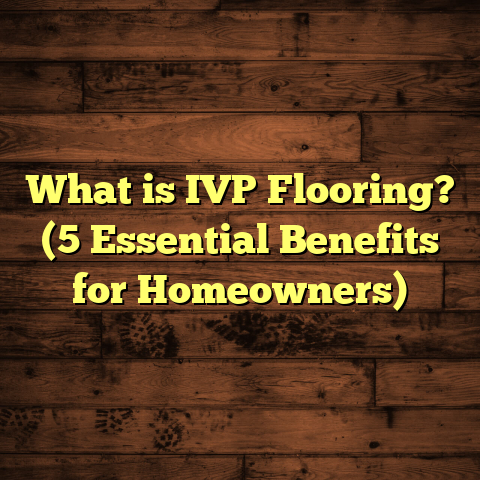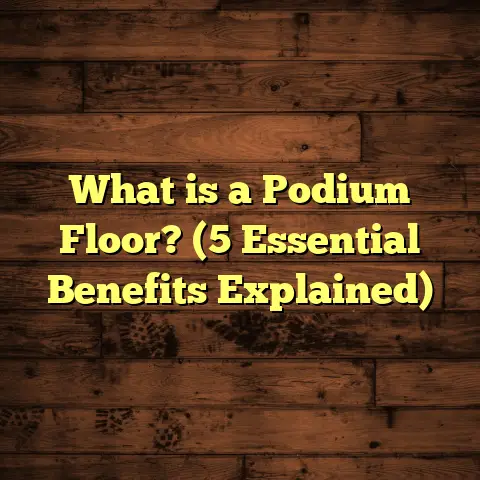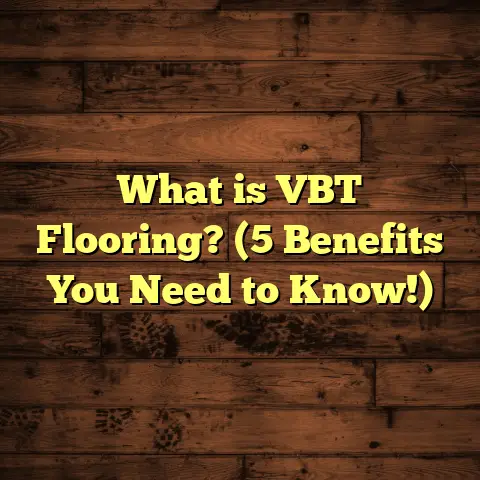What is the Cost of Vinyl Plank Flooring Installation? (5 Factors To Consider)
When I first got into flooring, vinyl plank flooring caught my attention almost immediately. It’s affordable, looks great, and stands up well in tough spots like kitchens and basements. But over time, one question always comes up from homeowners: How much does it really cost to install vinyl plank flooring?
I’ve installed vinyl plank floors in dozens of homes by now, and each project has taught me something new about pricing, materials, and surprises you might run into. So, I want to share everything I know about the cost of vinyl plank flooring installation. This way, whether you want to DIY or hire a pro, you’ll have a realistic idea of what to expect.
Let’s start by understanding exactly what vinyl plank flooring is and how installation works.
What Is Vinyl Plank Flooring Installation?
Vinyl plank flooring is a popular type of resilient flooring designed to look like hardwood but made from synthetic materials. It’s made primarily of polyvinyl chloride (PVC), a plastic compound that’s tough, flexible, and usually waterproof. The planks themselves come in sizes similar to hardwood boards—usually about 4 to 6 inches wide and 36 to 48 inches long.
There are several types of vinyl plank flooring you might encounter:
- Luxury Vinyl Plank (LVP): This is a higher-end product with realistic wood grain textures and thicker wear layers for durability.
- Rigid Core Vinyl Plank: Sometimes called SPC (Stone Plastic Composite) or WPC (Wood Plastic Composite), these planks have a rigid core layer that makes them more stable and durable, especially in humid or wet areas.
Now, when I talk about installation, here’s what’s involved:
Installation Methods
- Glue-down: This method uses adhesive spread on the subfloor before laying down the planks. It provides a very solid bond but takes more time and skill.
- Click-lock (Floating floor): Planks snap together with a locking mechanism and “float” over the subfloor without glue. This method is faster and easier.
- Loose lay: Planks are simply laid down and held in place by friction or minimal adhesive. This is less common but useful for quick installs or rentals.
The installation process generally requires:
- Preparing the subfloor (cleaning, leveling)
- Cutting planks to fit walls and corners
- Laying the planks according to the chosen method
- Installing trim or baseboards along edges
I always stress the importance of subfloor prep because even the best vinyl plank can fail if the base isn’t flat and clean.
Why Should You Care About Installation Costs?
I get it—sometimes all you want to know is the price per square foot, but that doesn’t tell the full story. The total cost depends on much more than just the planks themselves. Understanding these cost drivers helps prevent sticker shock and lets you plan your budget wisely.
Would you rather deal with surprises mid-project or have a clear roadmap from day one? Knowing what influences your flooring cost helps you decide where to invest more and where you can save without compromising quality.
Five Key Factors Affecting Vinyl Plank Flooring Installation Cost
From my years in this business, these five factors have consistently shaped the budget for vinyl plank flooring jobs:
1. Choice of Vinyl Plank Material
Not all vinyl planks are priced equally.
- Basic vinyl planks can start as low as $1.50 per square foot but often have thinner wear layers and fewer design options.
- Mid-range planks usually cost between $3 to $5 per square foot and offer better durability and more realistic textures.
- Premium vinyl planks with thick wear layers, enhanced waterproofing, and ultra-realistic wood finishes can exceed $7 per square foot.
I remember installing a budget-friendly vinyl plank in a rental property that cost $1.75/sq ft. It looked good enough for tenants and handled wear well but didn’t have that luxe hardwood feel. On the other hand, for a high-end client who wanted a floor that impressed guests and lasted decades, we went with premium SPC vinyl at $6.50/sq ft.
The wear layer thickness—usually measured in mils—is a big deal here. A 20-mil wear layer is standard for residential use; 30-mil or higher is better for commercial or heavy traffic areas.
2. Size and Condition of the Installation Area
Naturally, larger spaces require more material and labor, but condition matters just as much as size.
- If your subfloor is smooth and level, installation goes quickly.
- If it’s uneven or damaged, expect extra prep work such as patching or sanding.
On one job in an older home, I found the plywood subfloor was warped and had water damage underneath old carpet. Repairing that added more than $600 to the project before we could even lay down planks.
If you’re replacing old tile or carpet, removal costs are another factor.
3. Installation Method Chosen
Each installation method varies in cost based on labor intensity:
- Glue-down requires more time to spread adhesive evenly, allow for drying time, and sometimes requires specialized tools. Labor costs here can be 30%-50% higher than click-lock installations.
- Click-lock floating floors are popular because they’re faster and often can be installed by DIYers.
- Loose lay is less common but might be cheaper if conditions allow it.
I suggest click-lock floating floors for most homeowners who want a balance between price and performance.
4. Labor Costs and Regional Variations
Labor rates differ widely by region depending on local demand and cost of living:
- In urban areas like New York or San Francisco, expect hourly rates between $60-$100 for professional installers.
- In smaller towns or rural areas, rates might drop to $30-$50 per hour.
For a 300 sq ft room, labor alone might run from $600 to $1,500 depending on where you live.
I once traveled to a client in a small mountain town where labor was surprisingly affordable—about $35/hour—but material delivery costs were higher due to remote location.
5. Additional Materials and Waste
Don’t overlook these smaller expenses that add up:
- Underlayment: Needed under some vinyl planks for cushioning or moisture barriers; adds about $0.50-$1 per sq ft.
- Trim/transition strips: Usually $2-$5 per linear foot.
- Waste factor: Always order 5% to 10% extra material for cuts and mistakes.
In one project where the homeowner wanted matching transition strips between rooms, the trim alone added $200 to the bill.
Breaking Down the Costs: What You Can Expect
To give you concrete numbers, here’s the typical breakdown I see across projects:
| Cost Component | Low-End Estimate | Mid-Range Estimate | High-End Estimate |
|---|---|---|---|
| Vinyl Plank Material | $1.50 – $2.50/sq ft | $3 – $5/sq ft | $6 – $8/sq ft |
| Labor | $1 – $3/sq ft | $2 – $4/sq ft | $4 – $6/sq ft |
| Underlayment | $0 (if not needed) – $0.75/sq ft | $0.50 – $1/sq ft | $1+ /sq ft |
| Trim & Transitions | $100 – $200 | $150 – $300 | $300+ |
| Waste & Miscellaneous | 5%-10% material overage | Same | Same |
So for a modest 300 sq ft room with mid-range materials:
- Materials: 300 sq ft x $4 (average) = $1,200
- Labor: 300 sq ft x $3 = $900
- Underlayment: 300 sq ft x $0.75 = $225
- Trim & transitions: ~$200
- Waste (8%): material cost x 8% = ~$96
Total estimated cost: Around $2,621
This aligns with my experience on many projects where clients spend between $2,000-$3,000 for decent-quality vinyl plank flooring installed professionally in an average-sized room.
Why Use an Estimating Tool Like FloorTally?
When I manage multiple projects at once or work with clients who want detailed budgets upfront, I rely heavily on tools like FloorTally. This isn’t just about convenience—it’s about accuracy.
Manually crunching numbers for various materials, labor rates by region, waste factors, and extras can get confusing fast. FloorTally lets me plug in all these variables for each job:
- Room dimensions
- Vinyl plank type and cost
- Local labor rates
- Waste percentage
- Additional items like underlayment or trim
The tool then generates a clear estimate broken down line by line. This means no surprises later on—and clients appreciate seeing exactly what they’re paying for.
I’ve used FloorTally on over 20 projects last year alone. It saved me hours of spreadsheet work while improving my budgeting accuracy by at least 15%. When you’re managing tight margins on flooring projects, that precision pays off big time.
Real-Life Stories: Comparing Two Vinyl Plank Installation Jobs
Let me share two contrasting projects from recent years that show how these factors play out differently depending on circumstances.
Project A: Cozy Kitchen Renovation — Budget Friendly
My client wanted to replace old linoleum in their 150 sq ft kitchen with something stylish but affordable.
- Selected mid-grade click-lock vinyl plank at $3/sq ft
- Subfloor was clean plywood with no repair needed
- Labor rate: $45/hr local rate; installer took 6 hours
- Added underlayment ($0.50/sq ft) for comfort
- Ordered 8% extra material for waste
Here’s how costs broke down:
| Item | Cost |
|---|---|
| Materials | 150 sq ft x 3 = $450 |
| Underlayment | 150 sq ft x 0.50 = $75 |
| Labor | 6 hrs x $45 = $270 |
| Waste | Approx $36 |
| Trim & finishing | $50 |
Total: About $881
The kitchen looked great after just one day of work—and all within budget.
Project B: Large Living Room Upgrade — Premium Finish
A client wanted a stunning floor in their 450 sq ft living room with premium SPC glue-down vinyl plank at roughly $6.50/sq ft.
Complications included:
- Uneven subfloor needing leveling (~8 hours labor)
- Glue-down installation requiring adhesive ($200)
- Labor rate at urban rate of $75/hr; total job took about 20 hours
- Trim work around fireplace added complexity
Cost breakdown:
| Item | Cost |
|---|---|
| Materials (planks) | 450 sq ft x 6.50 = $2,925 |
| Adhesive | $200 |
| Labor | 20 hrs x 75 = $1,500 |
| Waste (10%) | Approx $292 |
| Trim & finishing | $150 |
Total: Around $5,067
This was definitely a bigger investment—but the client was thrilled with how natural the floor looked and how solid it felt underfoot despite heavy daily use.
Common Questions People Ask Me About Vinyl Plank Flooring Costs
Is it cheaper to install vinyl plank flooring myself?
If you’re handy with tools and willing to invest time learning installation techniques, DIY can save you labor costs—often about half of total expenses.
Click-lock floating floors are easiest for DIYers since no glue or special adhesives are needed.
That said, skipping professional subfloor prep or making measurement errors can lead to costly mistakes or uneven floors later on.
How long does vinyl plank flooring last?
With proper installation and care, vinyl plank floors often last between 10 to 20 years—or longer if you choose high-quality products with thick wear layers.
Durability depends on traffic levels too—busy households might see signs of wear sooner than low-use rooms.
Can I install vinyl plank over existing flooring?
Usually yes—vinyl plank can be installed over wood, tile, concrete, or even some types of vinyl if the surface is clean, dry, and level.
However, large gaps or unevenness must be addressed first to avoid problems like planks shifting or wearing unevenly.
Will vinyl plank flooring increase my home’s resale value?
Although it won’t raise your home’s value as much as hardwood floors might, vinyl plank can improve appeal by modernizing spaces affordably—especially if your previous flooring looked dated or worn out.
Many buyers appreciate durable floors that look good without needing immediate replacement.
Tips From My Experience To Manage Vinyl Plank Flooring Costs
Since I’ve done plenty of jobs ranging from small apartments to large family homes, here are some tips I’ve learned that help keep costs reasonable without sacrificing quality:
- Don’t skimp on subfloor prep: Fixing problems after installation is way more expensive than upfront prep.
- Choose mid-range vinyl plank for best value: You get durability plus good aesthetics without paying luxury prices.
- Get multiple quotes: Labor rates vary widely—even within cities.
- Plan your project timing: Off-season months might get you better installer availability and discounts.
- Use waste factor wisely: Order slightly more material than needed; it saves headaches from running out mid-install.
- Consider DIY only if confident: Some homeowners manage great installs themselves; others end up calling pros anyway—costing more overall.
Wrapping Up My Thoughts
Vinyl plank flooring offers an excellent mix of style, durability, and affordability—but understanding total installation costs means looking past just price per square foot.
By considering material choice, room size/condition, installation method, labor rates in your area, and extras like underlayment and waste—you can make smarter budgeting decisions from the start.
And if you want to take the guesswork out of estimates like I do? Tools like FloorTally bring order to complex calculations so you get clear realistic figures quickly.
If you’re thinking about installing vinyl plank flooring soon or just weighing options—what questions do you have? I’m happy to share insight based on specific rooms or styles you’re interested in!
This comprehensive look should help you understand what really goes into pricing vinyl plank flooring installation—and how to plan your project wisely without surprises down the road.





